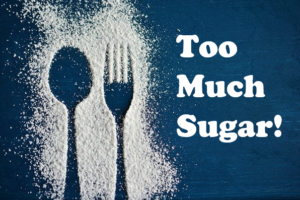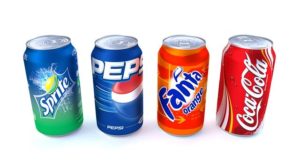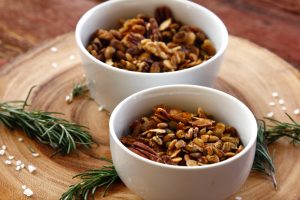 This probably won’t come as a shock,
This probably won’t come as a shock,
but sugar has been in the news again this past week. You are probably thinking…what now?
In case you missed it, an investigation has determined that the sugar industry, starting in the 1960s, developed a systematic effort to clear sugar as a contributor to heart disease and point the finger at fat. Basically, the food companies paid scientists to make us believe that it wasn’t sugar, but fat, that was responsible for heart disease.
Why?
Of course, if “fat” was considered “the bad guy,” this would cause people to consume more sugar and less fat. So, information, research and legislation were pursued that ultimately led to nutritional guidelines that recommended a low-fat diet. Hence, the “low fat” and “no-fat” revolution that lasted well into the 1980’s! Of course, what happens when you take the fat out of food? You have to add sugar to bring the taste back! And, that is exactly what the food companies did. You have to admit, the sugar industry was very successful with its efforts (successful for the sugar industry, but unfortunately, not for the health of our country).
Let’s face it. Sugar is confusing.
Between the food industry, the scientists and the government, it has become way more complicated and confusing than it needs to be.
So, what do you really need to know about sugar? We are here to tell you!
Natural sugars and added sugars are NOT the same.
 Natural sugars are found in fruits, vegetables, dairy and other whole foods. For example, fruit contains naturally occurring fructose and milk contains naturally occurring lactose. So, how does this differ from added sugars? Well, these naturally occurring sugars come “packaged” in fiber and the foods they are in also contain a variety of vitamins, minerals, water and many other nutrients. The result is these sugars are released slowly into the bloodstream and are absorbed differently than added sugars.
Natural sugars are found in fruits, vegetables, dairy and other whole foods. For example, fruit contains naturally occurring fructose and milk contains naturally occurring lactose. So, how does this differ from added sugars? Well, these naturally occurring sugars come “packaged” in fiber and the foods they are in also contain a variety of vitamins, minerals, water and many other nutrients. The result is these sugars are released slowly into the bloodstream and are absorbed differently than added sugars.
Added sugars, on the other hand, especially when consumed in large portions, can turn into fat in the liver and prevent the liver from processing insulin properly. These added sugars provide no nutritional value and, even worse, create problems in our bodies. They contribute to a long list of issues including diabetes, inflammation, elevated cholesterol, depressed HDL (good cholesterol), hyperactivity, cancer, heart disease and tooth decay.
 4 grams = 1 tsp.
4 grams = 1 tsp.
This equation is incredibly useful to remember. Let’s take an example: a 12 oz. can of Coca Cola contains 39 grams of sugar (added sugar, that is). So, that means it contains almost 10 tsp. of sugar. But who drinks a can anymore? What about a 20 oz. bottle? It contains 65 grams of sugar (over 16 tsp.).
How much sugar should we consume each day?
We do need some sugar…it’s a carbohydrate that provides energy and fuel for our bodies. The problem is we get way too much of it, in the form of added sugars.
Recommendations vary depending on who you talk to, but the American Heart Association recommends limiting added sugars to 6 to 9 tsp. per day. How about that 12 oz. can of Coke? You got it, that one can is 10 tsp. of added sugar, which alone exceeds the daily recommendation.
Recent studies have shown that Americans average 22 tsp. of added sugars each day. That’s A LOT of added sugar!
The challenge is almost 80% of packaged foods in the United States contain added sugars. But what makes it really challenging is many foods we THINK are “healthy” (because they are marketed that way) in reality, have a lot of added sugars. Here are just a few examples:
- Yogurt: flavored yogurt can have over 20 g (over 5 tsp.) of added sugar in one serving.
- Cheerios Protein Oats and Honey: 17 g (over 4 tsp.) for 1 1/4 cup.
- Granola (e.g., Kellogg’s Low Fat Granola): 14 g (over 3 tsp.) in 1/2 cup.
- Instant oatmeal (e.g., Quaker Maple & Brown Sugar) has 13 g (over 3 tsp.) in one packet.
Plus, the sugar is hidden in these foods! It’s disguised as many different names in the ingredient labels.
Ingredients like barley malt, brown rice syrup, corn syrup, dextrose, maltodextrin, organic cane juice, tapioca syrup and so many more…these are all added sugar!
Check out this eye-opening comparison:
Imagine a typical day of striving to eat healthy…
- 1 1/4 cup of Protein Cheerios with 1/2 cup skim milk
- Tropicana Orange Juice (4 oz)
- Snack – Special K Dark Chocolate Protein Granola Bar
- PB&J on whole wheat bread with 2 Tbsp of Peter Pan Peanut Butter and 1 Tbsp Smucker’s Grape Jelly
- Green Salad with 2 Tbsp Dorothy Lynch salad dressing
- Snack – Noose Strawberry Rhubarb Yogurt (4 oz)
- Whole wheat spaghetti with 1 cup Prego Traditional Spaghetti Sauce
- Dessert (because you ate healthy all day!) – 1 cup of Natural Vanilla Ice Cream with 1 Tbsp of Hershey’s Chocolate Syrup
This “healthy eating” day contains a total of 135 grams of sugar (over 33 tsp.)…and over half of this is added sugar. That means over 16 tsp. (or 1/3 cup!) of added sugar, which is well over the recommended 6-9 tsp. of added sugar per day! And, this doesn’t even include drinks…just imagine adding a soda or a sugar-laden coffee to this total!
What if, instead, you focused on eating REAL food throughout the day?
Here is what a day might look like enjoying Eat REAL America meals…
 One small orange and 3 Mini-Frittatas
One small orange and 3 Mini-Frittatas- Snack – Spiced Mixed Nuts
- Loaded Chicken Salad Sandwich
- Snack – 1/2 cup fresh strawberries plus Air Popped Popcorn with coconut oil and sea salt
- One-Pot Spaghetti Puttanesca
- Caesar Salad with Avocado Dressing
- Dessert – Harvest Pumpkin Bar
This day of eating REAL totals 44 grams of sugar, of which only 12 grams (3 tsp.) is added sugar. Huge difference!
So, what can we do?
- Don’t obsess about natural sugars in fruits, vegetables, dairy and other REAL foods.
- Read those ingredient labels to know how much added sugar is lurking in foods before you consider eating them. New nutritional label laws are coming soon that will separately list “added” sugars, but for now they are simply lumped in with the total sugar.
- If you like to drink juice, buy 100% juice, and remember…a serving is just 4 oz!
- Fruit is “nature’s candy” — serve sliced fruit for dessert.
- Limit added sugars. You don’t have to eliminate them entirely…they can provide great flavor when added in small quantities to REAL foods, and it is OK to occasionally indulge in your favorite sugar-laden treat.
So, it all comes back to those three simple words:
EAT REAL FOOD!
To learn even more about sugar, consider watching the documentary, Fed Up. See our coaching tip for more on this great film — it’s a must see!
 LEARN MORE ABOUT THE NAPKIN!
LEARN MORE ABOUT THE NAPKIN!



Thank you for giving us this information! I did read it quite a while ago here (thank goodness!). My medical provider, Kaiser, which touts prevention, hasn’t sent or provided this information, so clearly given here, and now I KNOW added sugar has been a HUGE issue for me all my life. I am SOOO grateful to have gotten this information, first from the DIETFREE Lifestyle Guide, Habit 4, “Tame Your Sweet Tooth,” page 56, and then from your coaching tips, and an incredibly helpful step, you have updated your recipes to match the label requirements in our grocery stores and show how much ADDED sugar is in the recipes. That has enabled me to really get a handle on how much ADDED SUGAR I eat each day, and keep it at or under 24 grams most days, which has also enabled me to get much better control my blood sugar. I am SO grateful. Thank you!!
Sappho – Thank you for sharing, we are so proud of you! Your success has been a blessing for us to watch – we are grateful for YOU! Your feedback, comments and sharing is what keeps us motivated and inspired to continue to help others!